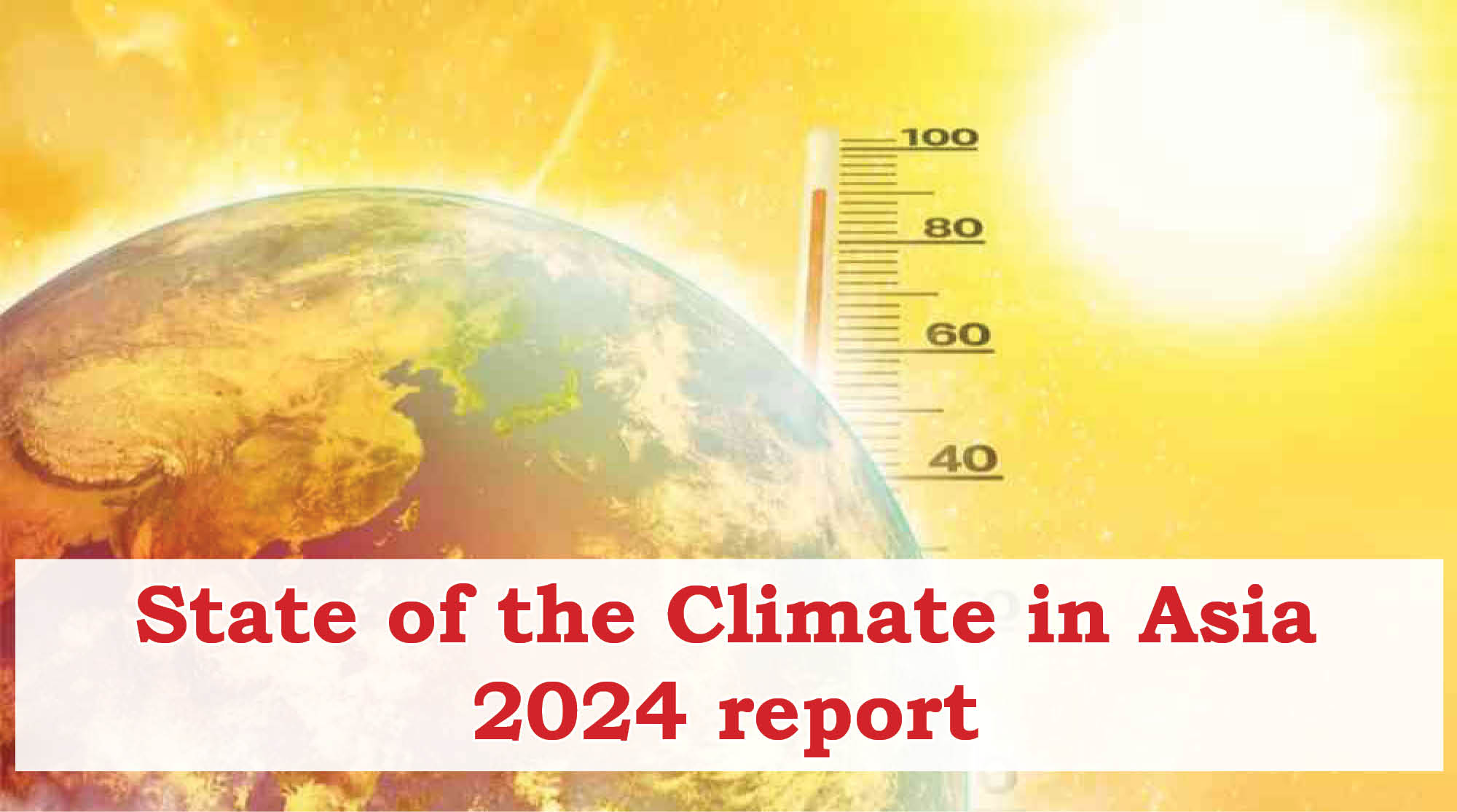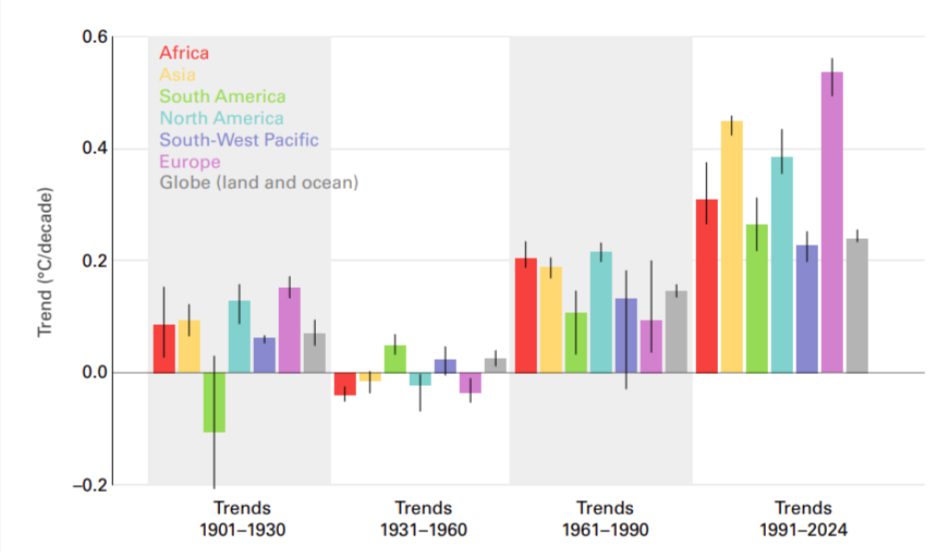Context:
The World Meteorological Organization (WMO) has released its State of the Climate in Asia 2024 report, painting a stark picture of intensifying climate change impacts across the continent. Asia is now warming at nearly twice the global average, with the 1991–2024 trend almost double that of 1961–1990. This rapid warming has triggered a rise in extreme weather events, putting immense pressure on lives, livelihoods, ecosystems, and economies.
Key Highlights of Report:
Rapid Warming and Record Temperatures: In 2024, Asia recorded an average temperature 1.04°C higher than the 1991–2020 baseline, making it either the warmest or the second warmest year on record, depending on the dataset. This is consistent with a longer-term warming trend where land areas—especially in large continental regions like Asia—are heating up faster than the oceans.
Several regions experienced extreme and prolonged heatwaves. From April to November, East Asia saw recurring temperature spikes. Monthly average temperature records were broken multiple times:
- Japan in April, July, and October,
- Republic of Korea in April, June, August, and September,
- China in April, May, August, September, and November.
Southeast Asia, Central Asia, and parts of the Middle East were also hit by intense heatwaves. Myanmar set a new national temperature record of 48.2°C in 2024.
India was significantly impacted. Several regions experienced deadly heatwaves that led to over 450 reported deaths. In addition, multiple extreme weather events were recorded:
- Over 350 deaths due to landslides caused by intense rainfall in Wayanad, Kerala.
- Around 1300 fatalities due to lightning strikes across various states.
Glacier Melting Accelerates in the Hindu Kush Himalayas: The report highlights an alarming trend of glacier retreat across high-mountain Asia, particularly in the Hindu Kush Himalayan region, which is the origin of major Asian rivers like the Indus, Ganges, and Brahmaputra. These rivers support the water needs of nearly a quarter of the world’s population.
Between 2023 and 2024, 23 out of 24 monitored glaciers in this region showed continued mass loss. The main causes were:
- Reduced winter snowfall.
- Intensified summer heat.
Significant glacier loss was reported in:
- Central Himalayas – covering parts of Nepal, Sikkim, and the Tibet Autonomous Region.
- Tian Shan range – stretching across China, Kyrgyzstan, and Kazakhstan.
Marine Heatwaves and Rising Sea Surface Temperatures: Asia’s oceans are warming at a dangerous pace. The sea surface temperature (SST) has been rising at a rate of 0.24°C per decade, almost double the global average of 0.13°C per decade.
In 2024, the continent recorded its most extensive marine heatwave since satellite records began in 1993:
- Affected nearly 15 million square kilometers of ocean – about one-tenth of the Earth’s total ocean surface.
- Especially intense warming was recorded in the northern Indian Ocean, Yellow Sea, East China Sea, and waters around Japan.
Rising Sea Levels Threaten Coastal Populations: The Indian and Pacific Ocean sides of Asia have seen sea levels rise faster than the global average. This poses a direct threat to low-lying coastal cities and island nations, increasing the risk of:
- Coastal flooding,
- Saltwater intrusion into freshwater systems,
- Loss of habitable land and displacement of communities.
Extreme Weather: Asia faced a range of destructive weather events in 2024:
- Heavy rainfall events caused widespread flooding and landslides in several countries, resulting in significant casualties and displacement.
- Tropical cyclones left a trail of destruction across coastal regions.
- Severe droughts impacted agriculture and water supplies, leading to heavy economic losses and worsening food insecurity.
India, in particular, witnessed the compounded impacts of rain-triggered disasters, deadly heatwaves, and lightning-related deaths, underscoring the need for robust disaster preparedness and climate adaptation strategies.
The Urgency of Early Warning Systems: The report underscores the critical importance of early warning systems and anticipatory action in reducing climate-related losses. A case study from Nepal demonstrates that communities with access to strengthened early warning systems were better able to respond to weather extremes, safeguarding lives and livelihoods.
Socioeconomic Impacts of Weather and Climate Hazards:
Climate-related disasters such as floods, droughts, storms, and heatwaves are causing widespread and interconnected socioeconomic impacts:
· Food Insecurity: Crop failures and livestock losses from extreme weather are worsening food insecurity globally. This is now one of the worst food crises in modern history.
· Population Displacement: Climate events force large-scale displacement, straining local resources, increasing health risks in shelters, and triggering social instability.
· Economic Losses: Infrastructure, agriculture, and livelihoods are severely affected, slowing economic recovery and deepening poverty in vulnerable regions.
· Widening Inequality: Climate shocks disproportionately impact poorer and marginalized communities, worsening inequalities (SDGs 1, 2, 3, 4, 5, 6, 7, and 10), especially for women and girls.
· Global Spillover Effects: Disasters affect global markets through rising food prices, disrupted supply chains, and increased humanitarian costs, threatening global economic stability.
About World Meteorological Organization (WMO):
The World Meteorological Organization (WMO) is a UN specialised agency responsible for weather, climate, water, and related geophysical sciences. It was established on 23rd March 1950 through the WMO Convention and evolved from the International Meteorological Organization (IMO) formed in 1873.
· Headquarters: Geneva, Switzerland
· Members: 192 Member States and Territories (including India)
· Functions: Coordinates global meteorological, hydrological, and climate-related activities.
Policy Relevance and Way Forward
The State of the Climate in Asia report provides vital data to inform national and regional climate policies. It highlights that urgent action is needed in the following areas:
- Strengthening climate resilience through early warning infrastructure,
- Protecting water sources in glacier-fed river basins,
- Safeguarding marine ecosystems from warming seas,
- Mitigating urban heat risks, especially for vulnerable populations,
- Accelerating adaptation strategies in agriculture, infrastructure, and disaster management.
As Asia accounts for over half the world’s population, the impacts of climate change in this region will have global repercussions. The findings from this report should serve as a wake-up call for governments, communities, and stakeholders to act swiftly and decisively.
Conclusion:
The year 2024 marked a turning point in Asia’s climate trajectory. With record-breaking heat, widespread glacier loss, marine heatwaves, and extreme weather disasters, the region is under mounting pressure. If current trends continue, the consequences for food security, water access, public health, and biodiversity will be profound.
The WMO report sends a clear message: climate change is not a distant threat—it is a present and escalating crisis. Asia, home to some of the world’s most populous and climate-vulnerable countries, must now lead the way in climate adaptation, mitigation, and resilience-building.
| Question: Discuss how extreme weather events are exacerbating food insecurity, economic losses, and social inequalities in developing countries. Suggest policy measures to mitigate these impacts. |








